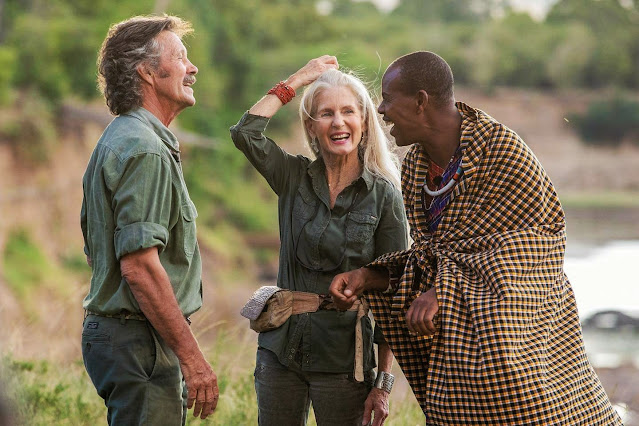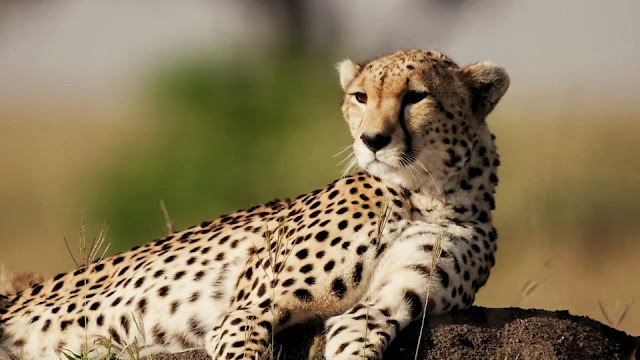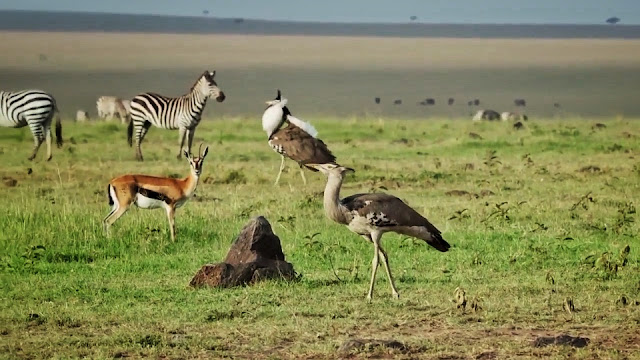Template of the second series of Big Cat Tales
Photo Credit: Animal Planet
Trailer of Big Cat Tales 2019, Series 2
Credit: Untitled Film Works/ https://youtu.be/GJpzwtpFS-c
Programme 1: Kingdom of Predators
I can't even begin to guess what the word 'paradise' means to you. But for me, it was always to come to Africa; to take a safari, to see, to listen to wild lions. To find a place like this – the Maasai Mara in Kenya. For as long as I've been living in Africa, the lion has represented to me the iconic African creature, the symbol of courage, of strength. And the Mara is simply a kingdom of predators, a kingdom of lions, and I don't think that we have ever – Angie and myself – being out on a game drive without finding a lion. It is that wonderful place for them. This is an extraordinary place – Musiara Marsh. We named these lions after this place. The Marsh Lions – forty years ago! And we feel most at home here, sharing time with these big cats. The sound of lions, big or small, just warms my heart!
The Trinity of the Tales: Jonathan Scott, Angela Scott and Jackson Ole Looseyia, refreshing hours during the filming session
Photo Credit: Abraham Joffe
— JONATHAN SCOTT is back on the trail of those big cats, whom he knows for years. Adding a vast sense of continuity to his catchy recapitulation, Angela Scott says: "I think it's a wonderful thought that lions have been here for thousands of years. These lions' ancestors were here!" Cut to another scene, displaying his suka (the colourful mantle of the traditional Maasai outfit) Jackson Ole Looseyia frames his concerns about leopards, the secretive cats of contrast: "In our culture, we call leopards 'shadows'. And [it is] exactly why I love leopards. Because it gives me that mystery. A quick screening of the memorable events from the current projection, and there begins the second series of Big Cat Tales.
 |
Charm, taking care of her cubs when featured in the first series of Big Cat Tales Photo Credit: Moses Manduku |
Unlike the first series, filmed in two different slots of the year, the second series of Big Cat Tales happened to be filmed from January to April 2019, comprising a total of three hour-long programmes on the latest updates of Mara's famous felines. The cameras are never late to capture the essence of the changes in the wilderness. And this time, indeed a lot of transitions took place in the scene. We are not talking about the changes in the landscape of the Mara, but some subtle familial transformation drastically shifted the dynamics of the Marsh Pride of lions to a different context. The pride have lost their oldest matriarch, Charm. She gave birth to her final litter of two cubs in late 2016, and the other lionesses had seven more cubs (Moja, Mbili and Solo, as well as Kali's four tiny cubs) along with them. But the two males, Askari (Rafiki) and Mpole (Karibu) seemed to largely neglect their patrolling duties, as they tolerated the presence of both the Six Warriors (otherwise known as Bila Shaka Males) and the Kichwa Males within their territory without response. The Marsh Pride lionesses then lost confidence in the males and led by Charm, took the risk of moving away to Leopard Gorge, 8 kilometres away from their core territory in Musiara Marsh. The gamble of moving to unfamiliar territory did not pay off and most of the cubs – Mbili, Solo and one of Kali's cubs were lost, including the two tiny cubs of Charm. Meanwhile, the duo of males completely abandoned the pride and instead took over the Acacia Pride (often called Cheli and Peacock Pride). Then in early 2018, Charm was seen for the last time in the Leopard Gorge area, having disappeared soon after. The loss of Charm signalled the end of the era of the Three Graces, and the beginning of another new chapter for the Marsh Pride.
Cloudy Eye (Above) and Kabibi (Below) near Dave's Tree
Photo Credit: Animal Planet
Jonathan expressed his joy when in this series he shared the arrival of a new generation in the Marsh Pride's crèch. This time, there were two mothers, Charm's daughter Cloudy Eye (Rembo) and Bibi's daughter from her last litter, Kabibi, sharing the responsibility of four tiny cubs, not more than eight weeks old. The mothers were now spending their time under the shade of Dave's tree, powerfully highlighting an innate sense of continuation: "This is where we've seen generations of Marsh Pride lionesses come here, bring their cubs, looking for safety. [...] One of the really extraordinary things about this, this is where we were with Charm and her two little cubs, not so long ago," Jonathan pointed out. Indeed, this area and Dave's Tree happen to be one of the safe hiding places for the cubs when they are a little grown-up, mobile enough to move around the corner along with their mothers and sibling. Whenever we watch lions, there lies the necessity of identifying each one of them proficiently. The photographs help prolifically in this deed and as Angela points out this time, the needs of recorded frames just turned out to be absolutely befitting for the viewers. Two years ago, Rembo was endowed with the name Cloudy Eye due to the condition of her retina. This time, it completely cleared up. Recognising her solely on the basis of her eye could have been a gross error in identifying, especially to the untrained observers. In a crèch, it often turns out to be confusing to say which cub belongs to which lionesses, but assumptions can be made. Basing upon Kabibi's grumpy behaviour toward one cub, the presenters came to a conclusion that three of the cubs may belong to her, while the slightly ignored one – the little girl might be Cloudy Eye's cub. Whatever the biological maternal framing was, it immediately turned out to be an absolute joy to watch a new generation of Marsh lions thriving in their core territorial domain.
 |
The four Marsh cubs, tucked in the lugga Photo Credit: Animal Planet |
 |
Surrounded by Peril: Cloudy Eye and Kabibi taking refuge on the Dave's Tree to defend themselves Photo Credit: Animal Planet |
With the lions doing seemingly well, time to catch up with the spotted cats knocked soon. Jonathan headed back to Olare Motorogi Conservancy, which borders the Mara Reserve, blessed with a low density of visitors – an ideal place for the leopards. In fact, this is where an old friend of Big Cat Tales was supposed to be. Fig was the female leopard who was featured in the first series of Big Cat Tales. At that time, she was with her five-month-old female cub Figlet, often fondly called Twiglet at times. Figlet became independent, living life on her own. Fig, however, was now framed with another single survivor in the litter – a three-month-old female called Maridadi, a Swahili word of "the sweet one". Leopards that the Big Cat People followed over four decades, some of them barely managed to raise even twenty per cent of their cubs. In a domain, surrounded by lions and hyenas, leopards are often pushed to their limits. Despite the odds, relishing moments in the company of mother and cubs is simply worth sharing. But, as we have seen the turning table for the big cats, even the lion cubs too can be in mortal danger at times, especially, when confronted by buffaloes. The big herds often turned out to be a massive trouble for the Marsh Pride in past. The mothers of the cubs, Kabibi and Cloudy Eye, have grown up envisioning the problem just in front of their eyes. For the time being, they have not many options but to get stuck on top of the Dave's Tree, keeping their cubs hidden at the base. Buffaloes aim at lions for good reasons. In African savannah, lions are the only predators that frequently push their luck to take down buffaloes, especially, when they are well backed up by several experienced pride members and by the pride males in particular. Eventually, losing interest in the hidden cubs, the buffaloes moved on. The mothers came down to reunite their cubs and all seem to be fine. This is just one of the alarming moments in the cubs' life. They would probably be more cautious if such a predicament reoccurs.
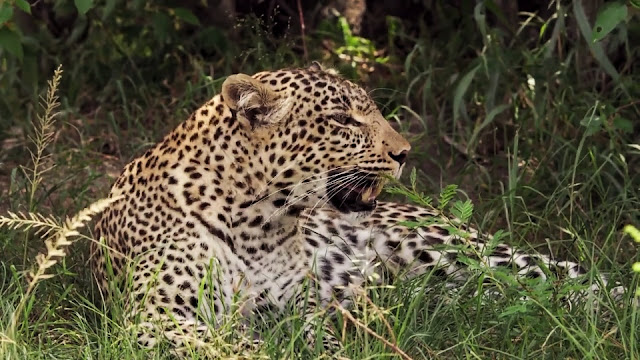 |
Fig the leopard Photo Credit: Animal Planet |
 |
Maridadi, Fig's three-month-old daughter Photo Credit: Animal Planet |
Within this milieu of turning tables of trials and tribulations, Jackson was now happy to share his trail with the cheetahs. In the last series, he was presenting the tale of Malaika the cheetah and her two adolescent cubs. Sadly, Malaika died in 2018. In his "Cheetahs in the Mara — A Creative Adventure Photography," Denisei Ippolito, the ace wildlife photographer and writer says:
In March of 2018 stories of Malaika's death started to surface. The specifics still remain a mystery, but she is believed to have drowned or been eaten by crocs while crossing the Olare Orok River. Malaika's caring nature towards her cubs along with her excellent hunting skills have made her legendary.
When her sons were nearly twenty-month-old, Malaika met Tano Bora, the Five Cheetah Boys and showed signs of oestrus – ready to bring forth another generation. It is really sad to lose one of the great stars of the Mara, the bearer of a fascinating legacy and so many memories.
A known face is now to appear on the screen. Amani was an adult female cheetah who has been known to both the guides and tourists for so many years. She happened to prove her excellence and commitment as a mother in the form of her thriving previous litter. This time, Jackson was delighted to catch up her with her three nine-month-old cubs – two females and a male. Though they had a long way to go on the trail alongside their mother before independence, they were already showing some tricks, helpful in the deed of hunting down prey. Giraffes are famous for having the top of the gardenia bushes trimmed, making them akin to the carefully crafted hedges of one's garden, and Amani's cubs just loved to play around and sit on top of the bushes.
 |
Doa, the mating guard Photo Credit: Animal Planet |
"Message from Simon, our spotter from Governors Camp – he has found five of our Six Warriors. Those are the Marsh Pride males, but right now, they are footloose and fancy-free, and looking for other females," affirmed Jonathan while hurrying to catch up with the coalition of the Marsh Pride rulers. Pointing out at the two youngest members of the coalition, namely, Kiok and Kibogoyo, he renovates the essence of Africa. Their bigger colleagues are not far away. They are the same males who invaded the March territory at the end of 2017, and terrorised the females and the cubs, prompting them to move on to the Leopard Gorge. Now, these males have estimated themselves as the dominant ones. Two years ago when they first invaded the Marsh, they were about three-and-a-half to four-year-old, bearing scruffy mohawk manes, but now they have developed attractive dark manes around their neck and chest. While Doa is seemingly representing the honest signs of his maturity, Baba Yao, the dominant one of the bunch, is seen responding with a typical flehmen face, checking out whether the young female from the Topi Plains Pride is ready to mate. Koshoke, another dark maned and long-faced male is seen guarding the female in oestrus. Under a small shade of a tree, four of the Warriors decide to move on and one of them is filmed having a courtship with the new female, foregrounding the path of a new generation of their gene pool.
 |
Kiok, one of the two younger members of the Six Warriors coalition Photo Credit: Animal Planet |
 |
Koshoke and Kibogoyo Photo Credit: Animal Planet |
The crew just happened to solve the mystery of the Marsh males. Six happened to be admittedly a big number in a coalition like this, and being backed up by such a great number, the Warriors consider every patch of ground to be their own till this date. In lion society, success is definitely counted in numbers but what we have to remember at times is such a big number can also lessen the sense of security in the nuclear bonding of the lionesses. Due to their expansionist outlook, the Warriors were spending time outside their core territory for a prolonged period, pushing the much-needed security of the crèch of the lionesses at stake. Ever since their arrival and exploitation, the Marsh Pride had been fragmented into small chunks. While Dada and Kali (as Kito was renamed after the beginning of the show in 2017) were pregnant, Kabibi and Cloudy Eye were solely working hard to secure enough meal for themselves and the four small cubs. Leaving cubs vulnerable, they set in the morning for hunting down dinner and, as Jackson caught them up one evening, their hunting efforts seemed to get disintegrated. So far, they had been fixing their aim on a small group of warthogs. In the lean times without the mighty herds of migration, lions are forced to rely on the residential prey like warthogs and buffaloes. Although these short-legged pigs are relatively easy to catch, they pose quite a great threat in the form of a couple of sharp lower tusks beside their lower jaws, underneath the big curved ones. Besides, they are extremely agile and responsive enough in moments of danger. It was, therefore, not so surprising that despite having multiple attempts to bring down at least one of them, why Kabibi and Cloudy Eye were getting slipped quite frequently. As Jackson pointed out at this juncture, they had been working hard since 10 in the morning, and it was really saddening to see their efforts going in vain. Their cubs happened to be hundreds of metres away. How will they get in touch with their mothers remains a major interrogation as the light is lost, and the day was about to be over.
Programme 2: Stripes vs Spots
How many people have the privilege of naming a group of lions and following them for more than half their life? And, to be able to this day – still look at those scrapbooks and remember all those individual characters – Half-Tail, Honey, Bibi, Kabibi, Cloudy Eye — the Marsh lions, the lions we named over forty years ago, the lions that we're still watching to this day. We always feel the pull, the tug at our heartstrings, bringing us back to this place – not just the Maasai Mara, but this place — Musiara Marsh.
 |
Kelele enjoying a play-fighting session with one of his elder cousins Photo Credit: Animal Planet |
— JONATHAN'S RECAPITULATION of their tenure, as they have been spending at the heart of wild paradise, brings forth the essence of a rejuvenated continuity at the outset of the second programme of the second series of Big Cat Tales. The fragmented splinter groups of the Marsh Pride of lions were roaming all around their extended home range. Driving across the waterlogged trail of Bila Shaka Lugga, Jonathan caught up with two of the lionesses from the pride who had been living on their own along with a handful of cubs. Little Red and Spot are daughters of Sienna, the erstwhile matriarch of the Three Graces. They were born in early 2014 along with their brother Topknot, who followed the pawprints of Red and Tatu (sons of Sienna and Charm, respectively) to form his new coalition. When the Marsh Pride faced huge challenges due to losses to human errors (the poisoning of Siena and Bibi in December 2015) both the females stayed with Charm for some time, and started their life as young carefree lionesses when the Marsh Pride moved out of their territory in mid-2017. Spot and Little Red stayed in the Musiara Area, formed a bonding with the Warriors and gave birth in August 2018. Little Red sadly lost her cubs and since then, dedicated her attention and energy to help Spot to raise her son and daughter.
 |
Kelele, the star in the making Photo Credit: Animal Planet |
 |
Kelele following his mother's steps Photo Credit: Jonathan and Angela Scott |
 |
Spot's cubs with tiny Kelele Photo Credit: Animal Planet |
As Jonathan caught up with the duo, they were heading with their three cubs to the coalition of males, who Little Red happened to give birth of yet another litter, but only one male cub survived – the little Kelele. In Swahili, 'Kelele' is a word for "the noisy one". And indeed, he was quite an individual – always busy letting others know where he used to be. For a single lion cub in a litter, survival often turns out to be troublesome. Without the safety in number that is usually provided in a litter, Kelele happened to form a strong bonding with his two elder cousins – Spot's cubs. As the females and the cubs approached Baba Yao, one of the males from the Warriors' coalition, he was feeding on the scraps of a kill. While adult males allow young cubs to feed along with them, lionesses are often put at bay by them. The cubs are an important asset, not just to their mothers, but also to their fathers – the pride males. While Little Red seemed to be a bit worried seeing the cubs scampering on the block in the presence of the males, Kelele and the other two cubs were carefree. One cannot simply blame a lioness' anxiety over having both the adult males and little cubs in one frame because lionesses, at times, witness the heart-rending predicament of infanticide, performed by the new male intruders that come and take over a pride, overthrowing the existing pride males. Alongside Baba Yao, there have been two other adult males sharing the kill – Koshoke and Chongo. Chongo turned out to be quite a character in this series of Big Cat Tales. He was the father of some of the young cubs in the pride and pointing out him being groomed by his coalition partner, Jonathan introduced, "Okay, the male on the left – that's Chongo – that's Kelele's dad, or at least we think it's his dad. And the reason he's called Chongo, he's got one eye." In Swahili, 'Chongo' is a word for "one-eyed". The presence of the big males happened to be "the missing element" to Jonathan as he described, but their presence here at the Bila Shaka, the edge of their territory is not convincing enough since Kabibi, Cloudy Eye and other cubs were just too vulnerable and exposed to the probable invaders in the absence of their protectors. They should have been there with their full strength and confidence.
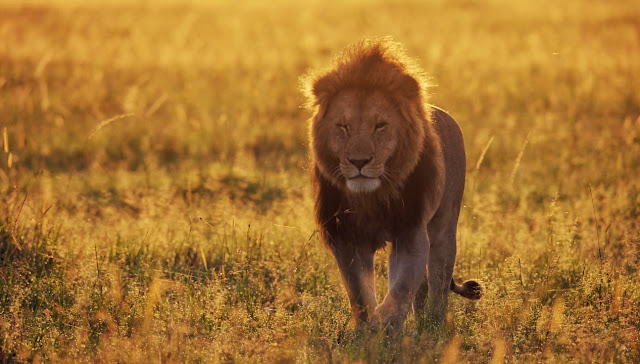 |
Chongo, the handsome hunk Photo Credit: Animal Planet |
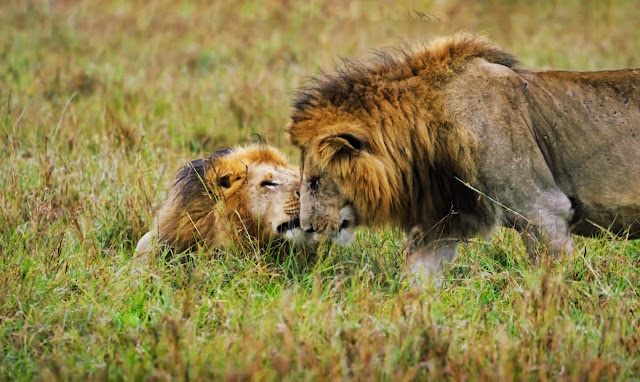 |
Chongo being greeted by his coalition partner, Koshoke Photo Credit: Animal Planet |
While Amani and her three cubs were having a bit of good luck, though the remaining scraps of their killed had just been stolen by a lioness, it is time for the crew to catch up with some of the magnanimous cheetah stars of the series. Tano Bora or the Fastest Five – the Five Cheetah Boys just turned out to be the tremendous force in the last series of Big Cat Tales to be reckoned with, and now they are back once again. As always acknowledged, five cheetahs in a coalition is a huge and effective force. Pointing out at Olpadan, the big male, Jonathan recognised him as the leader of the force and soon enough, following their trail, Jackson finds out that the cheetah coalition in a hunting mode. Marking on the branches of a fallen tree as 'their' check post, the males set off. Scanning the plains with their eagle-eyed filtration, they just tended to clear their intention of aiming at a local herd of zebras. Cheetahs usually do not go for adult zebras, but with such a powerful force to rely on, foals or the yearlings are often taken down. As the boys start their action, Jackson pinpointed his eyes through his binoculars and admits their determination. Jackson anticipates the anxieties of the zebra parents who just lost their offspring. They crossed the crocodile-infested river, and met the massive forces of the cheetah boys. Literally, it turned out to be a tug of war between "the stripes versus spots," as Jackson mentioned.
 |
The Five Cheetah Boys on the prowl Photo Credit: Animal Planet |
 |
Olpadan, the mighty 'boss' of the Tano Bora coalition Photo Credit: Animal Planet |
Cut to the other side of the spotted cats, Jonathan and the leopard crew were delighted to catch up with an old friend of Big Cat Tales – Olare the leopard. Two years ago, in the first series of the show, she was featured with her two cubs Makumbhwa and Ndogo, often being accompanied by her grown-up son, Jassiri. This time, although she was reported to be nurturing young cubs, the scene that Jonathan encountered is not convincing enough. Olare was bearing the signs of lactating around her tips, but there is no sign of the cubs. Furthermore, she just happened to solicit the attention of a large resident male, a bruiser called Golden Boy. Provoking the male to court, Olare designated the signal that she recently lost her litter. The Mara is a place, filled with competitors. It was no wonder that the cubs could be lost either to lions or hyenas. However, whether or not there would be a new generation around the Olare Orok Lugga, was yet to be seen. Fascinated by the appearance of Golden Boy, Jonathan admired his masculinity: "That is the biggest male leopard I have ever seen. He is huge. He looks almost like a jaguar. And his markings are so distinct. Black spots – rosettes, as if somebody had taken their fingers, dip them into black charcoal, and just boom, boom, boom – beautiful!" It was just a matter of time that would decide the whereabouts of a new leopard dynasty along the riverine forest.
 |
Peeping through the Thickets: Golden Boy, the bruiser Photo Credit: Animal Planet |
 |
Golden Boy quenching his thirst Photo Credit: Animal Planet |
In the last programme, we have seen how Kabibi and Cloudy Eye were getting desperate to secure a meal for themselves. The cubs were left alone, hungry. Their mothers did not manage to grab something satisfiable. Now as they tend to return where the cubs were left, the tension could be felt in the air. One of the cubs seemed to be missing from the group. Presumably, the little girl of Cloudy Eye. The other three immediately greeted their guardians. Worried about the absence of the cub, the lionesses looked around the corner. The scene turned out to be relaxing enough, not that agonising as it appeared to be initially since the missing cub is seen immediately running across the path to meet the rest of the family. Why on earth she got separated was anyone's guess, but the family reunion turned out to be soothing. Meanwhile, a few days later Dada joined her pride mates. She had recently given birth to cubs, but they were safely hidden in the deep reeds along the Marsh. The lionesses, though apparently enjoying being together at the moment, are pushing their own agenda when it came to raising their cubs. Kali (Kito) joined the other three females recently and judging from the wide-cut at her right cheek, everyone could assume her painful condition. The lionesses are frantically trying to grab the satisfying meal at this moment of hard times, but they are visibly getting distressed. It seemed perhaps Kali attempted to take down a warthog, whose razor-sharp lower canines eventually cut her cheek apart, from the corner of her mouth to the bottom of her ear. Recovery would certainly take enough time. Kali's injury just showed how tough and resilient these cats can be at times.
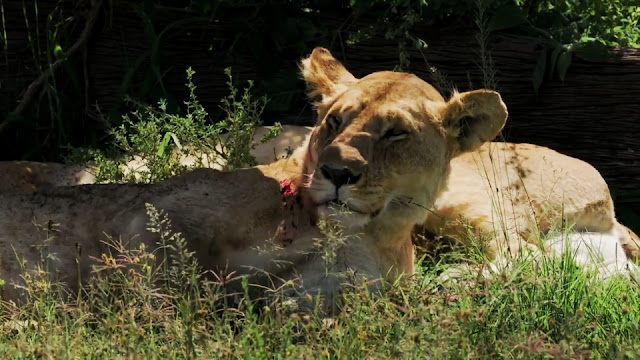 |
Kali, wounded by a warthog Photo Credit: Animal Planet |
 |
Dada, resting upon a tree Photo Credit: Animal Planet |
Programme 3: Peril on the Horizon
THE UNCERTAINTY of food seemed to be comparatively settled down in the Marsh, but being annoyed by the boisterous play-fighting of the cubs, their mothers took the refuge of a tree. Jonathan just related the affinity of the scene with a situation that Angela and the lion crew witnessed a couple of years ago – exactly the same place in the Marsh, and Kabibi and Dada seemed to enjoy the play session with their cubs – Moja, Mbili and Solo. For the time being, the Marsh had turned out to be a shelter of demand. While the lionesses here were desperately trying to have some peaceful hours out of the reach of the cubs, at least for some moments, a resident troop of baboons, however, were on the mission to spend their time in the shade. And adding salt to the injury of restlessness, two big bull elephants intended to wrestle and show off their strength against each other. They happened to be excited in the presence of the females of a local herd and, seem to be full of testosterone. Both the groups of lions and the baboons tend were tending to seek safe haven now. Meanwhile, one of the bulls breathtakingly takes up a broken log and tends to throw it on Jonathan's vehicle, prompting him to frame the situation in such a manner: "You can tell, this bull is full of testosterone. There are females around. He wants to show everybody, including me, who is the boss."
 |
Kabibi, treed by an elephant Photo Credit: Animal Planet |
For the cheetah family, Amani and her three cubs, things were going on smoothly. They seemed to be hunting well in the last week and now as seen in the episode, Amani was heading with her cubs towards a kill, made by a black back jackal. Usually, the cheetahs do not go for the kills made by other carnivores. It often turned out to be risky since the predator who killed it just might have been around the corner to put up a sudden blow. A jackal is no match for a cheetah. As Amani and her cubs approached, the jackal turned his back, letting the kill be grabbed by the felines. This just happened to be one of the rare scenes where the scavenging behaviour of cheetahs is caught in the action. Earlier, one such moment was caught in the camera when Amber the cheetah did the same thing of taking away a Thompson's gazelle kill from a jackal in September 2000, as filmed in the third series of Big Cat Diary. Later on in the final week of filming Big Cat Tales this year, Amani made yet another successful kill but had to lose scraps of it to hyenas.
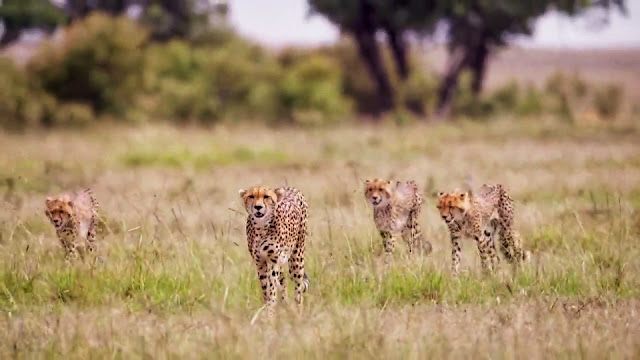 |
Amani and her cubs heading towards a kill made by black back jackals Photo Credit: Animal Planet |
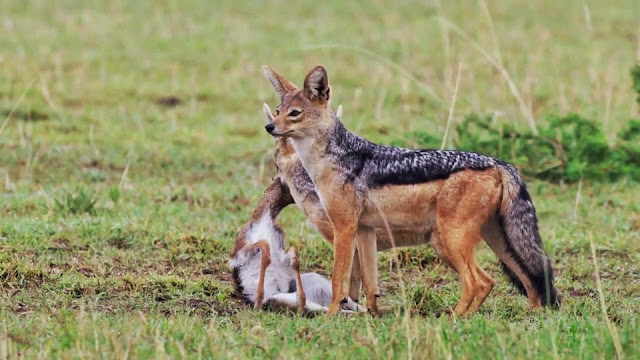 |
Soon after the arrival of the cheetahs, the jackal pair had to back off Photo Credit: Animal Planet |
Alongside the cheetah family that the crew have been filming for months, situations are offering several trials for the little female leopard called Maridadi. As Jonathan drove along Olare Motorogi Conservancy, the leopard country, he immediately tracked down Fig, resting up on a branch. Soon after, her cub turned up in the seen. And as it turned out, Fig was tending to move away a Thompson's gazelle carcass that she recently killed. Maridadi kept up following. One may ask, despite having enough security on the branches, why Fig is wishing to shift her kill. The leopard cubs often drag the remaining of a carcass to a manageable place to feed on comfortably, and by trying to do so, they often let the kill fell down. And, if there are hyenas around the corner, it would be the end of the meal, positing enough threat to the life of the cub: "There's still a good meal there, but obviously Fig feels – 'You know, if I take this down to the lugga – this thicker bush and just bury it. And then just feed at leisure with the little one,' where nobody can see her at all. Because even though this tree is pretty good, it's not full-proof." A leopard does not want to be seen either by its prey or by its enemies So, it is definitely a great treat to be able to see the secret moments of mother and cub together for the entire tenure of Big Cat Tales.
 |
Fig and Maridadi enjoying some peaceful hours Photo Credit: Animal Planet |
 |
Fig, carrying the remains of remainings of a Thompson's kill Photo Credit: Animal Planet |
Along the bank of the Mara River, commensalism was taking place as a few oxpeckers, belonging to both the species of yellow-billed and red-billed, were feeding on the slits of the red flesh of a hippo, standing on the river: "But you would wonder, why would the hippo just stand and let these birds just peck away its flesh? What's the benefit to the hippo? The oxpecker is keeping the wound clean. Dead flesh – off he comes, a meal for the teak bird and relief for the hippo. And it's just wonderful! It works to both species' benefit." On the other corner, a bunch of hippos are upset to see one of their relatives' carcasses being feasted by crocodiles. The hippo was probably killed during a territorial dispute. The Nile crocodiles of Mara can be up to 15 feet in length. No wonder, why one should be on his guard while crossing the river. A unique scene is demonstrated in the third programme of this series as the crocodiles too turned out to be submissive in front of the Scarface, the "Real Lion King" (taking the titular excerpt from Scarface, the Real Lion King, one of the books of children's literature series by Jonathan and Angela Scott, published by Cambridge University Press). Scarface arrived at the bank, prompting the crocodiles to back off. It was yet to be seen how much Scarface is willing to dine in the same meal with these gigantic reptiles. As his presence had always done in the past, it just resonated with the innate resilience of a male lion. Jonathan happens to capture the essence:
... and that just shows you the presence, the power that the lion has. But it also tells you something else. I think in human society, we revere courage, strength, power – the warrior. And that's why animals like Scarface are so appealing. I mean, look at him – he is battered, he is bruised, he is missing an eye, his teeth are wearing down. He is partly crippled in his back leg. But is he giving up? No. That's what I love. And what I never can be sure of, is this the last time I see him? And that's why I savour every moment in the presence of this male – Scarface, the real lion king.
Meanwhile, in the Marsh, the elephant trouble seemed to be giving a push to the seemingly settled down moments of the lionesses. This time, one of the cameramen was in a bit of technical trouble. As he was trying to film Dada stalking an adult male impala, the viewfinder of his camera got filled by the grey shade of the body flank of an elephant as he passed through the way. Jonathan mentioned this to be a good excuse to miss the frame. Dada too missed the chance to launch an ambush. But now the females and cubs of the Marsh Pride were perhaps exposed to even more dangerous adversaries, more perilous than hunger. As the Six Warriors were tending to expand their horizons, encompassing a wide area that includes the home range of the Marsh Pride and the Topi Plains-Ridge Pride, the core territory of the Marsh females became open to being invaded by various other males, alien to the area. Two new young males had trespassed into the territory, and they mean business. Scattering and dislocating a local clan of hyenas that had been feasting on a dead hippo in the lugga, the males tried to resonate their dominance. The four females, at this juncture, simply could do nothing without the profound support of the pride males. One may feel the tension in Jackson's voice when he uttered the ethos of the tensed motherhood – the lionesses had to protect something precious – their "children". Right at the moment when the predicament was tending to turn out to be grimmer, the miracle happened. Somewhere in the long grass, one of the Warriors arrived. Chongo was back! Tracing the magnificent arrival of at least one of the pride males in the area, the invaders immediately backed off. Considering Chongo's determination to save his territory from the trespassers, Jackson commented: "He knows what he is supposed to do. He says, 'My home is threatened! Girls, don't worry, I'm here,' [...] These lions must continue, coming and checking the Marsh Pride, and Chongo has done an amazing job. For today, the lionesses and the cubs are safe."
 |
"Trespassers will be prosecuted.": young invaders in the Marsh Photo Credit: Animal Planet |
 |
The Charging Chongo Photo Credit: Animal Planet |
With the returning of the Warriors to their core area, the hardships of the pride too seemed to be simultaneously recovering. Soon after the threat of invasion, Jonathan caught up Chongo, sharing a buffalo kill with two of the four females of the pride. Although the Six Warriors used to kill buffalo from time to time for themselves, on this occasion, the females grabbed the kill. It is customary in the lion society that the males would first estimate their dominance on the kill, and what Chongo was doing at the moment was simply conformity towards the lion ritual – the table manners of lion society. His dominance, however, was assertive enough to clarify how single-handedly he managed to chase away those two trespassers. But as time was passing, there came much pressure on him. Cloudy Eye and Dada moved into the kill along with the cubs. Though at times their dinner got interrupted by an elephant mother and her calf, the lions held on to the ground and as the cubs moved in, to try to dine with their older relatives, Chongo gently allowed them to feed alongside him, showing his genial fatherly care. Once again, the star felines of the Mara have just made Big Cat Tales a special endeavour. Drawing an excerpt from Angela Scott's narrative to a great extent, we too can heave a sigh of relief for the evergreen continuity of the ecosystem:
So the Marsh is place which is very dear to my heart. Jonathan and I have been coming here for years and years – thirty years and more. It's a place of water, and I think water attracts life. Whenever Jonathan and I need a break, we always say to each other – 'let's just go down to the mini Marsh.' And we'll come here, will have a cup of tea, and we'll read a book – and you feel rejuvenated. It's a place where you can settle and just listen quietly. [...] I think it's a wonderful thought that lions have been here for thousands of years. These lions' ancestors were here. And to me, there's a little bit of magic, and a little bit of reassurance that the world just continues without the hardened bustles of the human beings. Life here has this wonderful harmony. Everything in order, everything in its place. The animals just get on living with each other in perfect rhythm. Just carrying on as it has done for thousands and thousands of years.
Indeed, it is to turn the few more pages of their lives to renovate the quintessential essence of untamed wilderness at the heart of the wild paradise – the Maasai Mara National Reserve in Kenya. The Big Cat People, responding to the innate tug of the immense life stories of these cats at their heartstrings, are expecting soon to come back on the trail of their feline friends to chronicle yet another magnificent chapter of their lives.
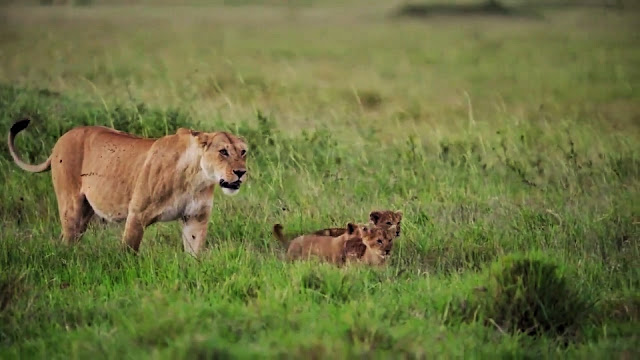 |
Cloudy Eye bringing the cubs to dine Photo Credit: Animal Planet |
 |
... and Chongo showing his fatherly affection, allowing the cubs to the kill Photo Credit: Animal Planet |
To be continued ...
Credits
Presented by
Jonathan Scott
Angela Scott
Jackson Ole Looseyia
Produced and Directed by
Abraham Joffe ACS
Dom West
Produced by
Abraham Joffe ACS
Associate Producer
Louis Cooper Robinson
Director of Photography
Abraham Joffe ACS
Dom West
Cinematography
Dom West
Blake Castle
Abraham Joffe ACS
Pete Matthews
Scott Turner
James Wood
Adam Lynch
Phil Thurston
Ian Pritchard
Shuan Hepple
Editors
Lorna-Jean Bradley
Assistant Editors
Neal Von Dinklage
Rika Borthwick
Dom West
Music Score
Adam Moses
Title Theme Composer
Lydia Davis
Sound Design
Simon Lister
James Martell
Andy Stewart
Charlie White
Sound Producers
Hamish Macdonald
Angelina Phengphong
Sound Studios
Squeak E. Clean Studios
Dialogue Editor
Tom Herdman
Colourist
Luciano Marigo-Spitaleri CSI
Mastering
Fred El-Harris
Motion Graphics
Vanderlesi Santana
Marcelo Fubah
Illustrator
Ramon Rodriguez
Compositor
Vanderli Santana
Post Production Supervisor
Dom West
Lorna-Jean Bradley
Production Accountant
Paul Nadso
Acknowledgement
Republic of Kenya
Kenya Ministry of Information, Communication and Technology
Kenya Ministry of Tourism and Wildlife
Kenya Tourism Board
Narok County Government
Maasai Mara National Reserve
Governors Camp
Mara North Conservancy
Olare Motorogi Conservancy
Kenya Wildlife Trust:
Mara Predator Conservation Programme
Blaire Joscelyne
Pow Wow Studios
Maniago Safaris
Safarilink Aviation
CS Tourism and Wildlife:
Honourable Najib Balala
Advisors to CS Tourism and Wildlife:
Fatma Muses
CEO Kenya Tourism Board:
Dr Betty Raddier
Governor of Narok County:
Honourable Samuel Ole Tunai
CS Tourism Narok County Government:
Honourable Lena Munge
The Grammaticus Family
Patrick Beresford
Governors Camp Staff and Safari Guides
Harrison Ole Nompaso
Simon Sitinei
Mandila Lemiso
Patrick Isainga
Daniel Gutambo
Nicolas Ledama
John Buckley
Anu Vohra
Annabella Francescon
Phyllis Joffe
Brian Heath
Hamish Macdonald
Philip Valentine
Greg Monson
Tony Nagle
Mark Bamford
Canon Australia
Dragon Image
Red Digital Cinema
F-Stop
Atomos
Polar Pro
Miller Tripods
For Animal Planet
VP of Production
Erin Wanner
Executive Producer
Dawn Sinsel
VP of Production Management
Sandy Haller
Production Co-ordinator
Valerie Moss
Produced by
Untitled Film Works


